Tri-State Transportation Campaign Written Testimony for the Committee on Oversight and Transportation and Infrastructure Committee, September 12th, 2023
Submitted by Corey Hannigan, Active Transportation Program Manager
Thank you for providing this opportunity to offer testimony on NYCDOT Streets Plan
implementation and several additional pieces of proposed legislation. For thirty years, Tri-State
Transportation Campaign has worked to promote sustainable transportation, equitable planning
policies and practices, and strong communities in the New York City metro area through
improving and expanding transit, meeting the region’s climate goals, preventing traffic deaths,
and making transportation equitable.
Bus and bike lane prioritization is vital
While we recognize that NYCDOT has been suffering from staff shortages and other challenges,
we are deeply concerned about the lack of progress by the DOT in meeting the goals of the
Streets Plan. New York City currently has the slowest buses in the United States. They are not
keeping up with MTA bus network redesigns. Poor bus service disproportionately impacts
immigrant and BIPOC New Yorkers who heavily rely on bus service and who need and deserve
frequent and reliable transportation.
NYC is currently non-compliant with the 2019 law (Local Law 195), which states “The master
plan due by December 1, 2021, shall include, at a minimum, the following benchmarks: (i) install
at least 150 miles of protected bus lanes, in coordination with the metropolitan transportation
authority, with such lanes located along a median where feasible, with at least 20 miles of such
lanes installed during the first year of such plan and at least 30 miles installed during each
subsequent year of such plan; (ii) implement transit signal priority in at least 750 intersections
along bus routes during the first year of such plan and at least 1,000 intersections during each
subsequent year of such plan or until transit signal priority is implemented in every intersection
where such installation is feasible along every bus route where buses capable of utilizing transit
signal priority are operated;”
It is imperative that the DOT report on progress that has been made, detail where progress has
fallen behind, and lay out a plan for coming into compliance with the law.
There have been multiple instances of busway, bus lane, and protected bike lane projects that
have been rolled back or delayed (such as the Fordham Road Busway and McGuinness
Boulevard redesign) or watered down in quality (such as reduced hours on the Flushing Main
Street busway and significant gaps in physical barriers on the Northern Boulevard protected
bike lane). These decisions are often being made at the discretion of the DOT, in direct conflict
with their legally required benchmark goals.
We have serious doubts about the likelihood that the city will meet its legally required goal of
150 miles of new bus lanes and 250 miles of new protected bike lanes by 2026.
Even before projects are rolled back, delayed, or reduced, often their initial scopes are woefully
inadequate. For example, the Bedford Avenue protected bike lane project stops one block short
of connecting with the Brooklyn Waterfront Greenway, and only provides safety treatments for
cyclists traveling in one direction.
Congestion Pricing Implementation Adds Urgency:
Research has shown that the success of congestion pricing in places like London were due in
large part to the fact that new bike and bus lanes were rolled out before the new tolls took effect.
With New York’s congestion pricing program set to take effect in Spring 2024, now is not the
time to be falling behind on offering residents outside the congestion zone alternative ways to
move around the city.
Other bills under current consideration:
○ TSTC supports Int 0261-2022. However, prohibiting parking from just five
intersections per borough per year is not nearly enough. Instead, we would like to
see New York City align with existing State law (N.Y. Veh. & Traf. Law
§1202.2.b), which prohibits parking within 20 feet of a crosswalk at any
intersection statewide. Currently, New York City overrides this state law, making
intersections less safe. Int 0261-2022 is a step in the right direction, but shouldn’t
be necessary in the first place.
○ TSTC does not support Int 0738-2022. Rather than more officer-based
enforcement, we urge the city to emphasize its Vision Zero approach of creating
safe systems. For intersections where speeding or red-light running is an issue,
we prefer the placement of red light and/or speed cameras, which avoid
issues of racial profiling and human error.
We would also like to see a mechanism for enforcing laws prohibiting parking on
sidewalks, in crosswalks, and in bike lanes (including by NYPD officers). There is
another city bill, which we do support, intended to address this issue – Int
0501-2022 – which has been stalled since April of this year.
○ Tri-State strongly supports T2023-4007. Without adequate, dedicated
investments in safety improvement projects, such plans amount to little more
than recommendations, and the communities that need them the most are often
the least equipped to do so.
Thank you for your attention to these important matters. TSTC looks forward to continuing to
work with the City Council and the NYCDOT on improving the lifeblood of New York City- our
streets- for use by our most vulnerable street users. The safety, equity, and livability of our City
depend on it.

